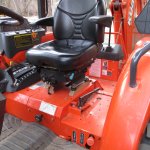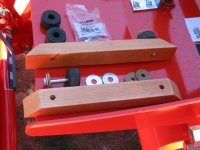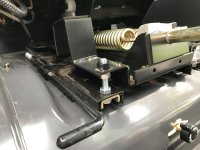rScotty
Super Member
- Joined
- Apr 21, 2001
- Messages
- 8,258
- Location
- Rural mountains - Colorado
- Tractor
- Kubota M59, JD530, JD310SG. Restoring Yanmar YM165D
It's was easy to make simple improvements to the Kubota seat.
The original seat was low, tilted too far forward, and rode too stiff. It made for a jolting ride over small bumps, and bottomed out over large ones.
The nice thing about the original seat is that being so simple makes it easy to improve.
The cost in time & money to improve the seat was near nothing, and the improvement was dramatic.
The downside is that it's now enough better that I haven't spent that $1K to buy the air ride seat I originally promised myself.....
The bolts are from Home Depot's metric assortment, and the rubber spacers from the junk box. HD or the local hardware store probably has something similar.
If not, Mcmaster.com has a huge assortment of rubber spacers & bumpers. Search under their "rubber bumpers" for the perfect part, but almost anything works.
Oh... also.....In the center of the front of the seat you can see a wood block I added to raise the seat safety switch to the new level.
Knowing what I do now about the M59 and it's peculiar pedal layout, I should have simply defeated the switch by plugging the wires togther.
rScotty
The original seat was low, tilted too far forward, and rode too stiff. It made for a jolting ride over small bumps, and bottomed out over large ones.
The nice thing about the original seat is that being so simple makes it easy to improve.
The cost in time & money to improve the seat was near nothing, and the improvement was dramatic.
The downside is that it's now enough better that I haven't spent that $1K to buy the air ride seat I originally promised myself.....
The bolts are from Home Depot's metric assortment, and the rubber spacers from the junk box. HD or the local hardware store probably has something similar.
If not, Mcmaster.com has a huge assortment of rubber spacers & bumpers. Search under their "rubber bumpers" for the perfect part, but almost anything works.
Oh... also.....In the center of the front of the seat you can see a wood block I added to raise the seat safety switch to the new level.
Knowing what I do now about the M59 and it's peculiar pedal layout, I should have simply defeated the switch by plugging the wires togther.
rScotty
Attachments
Last edited:


